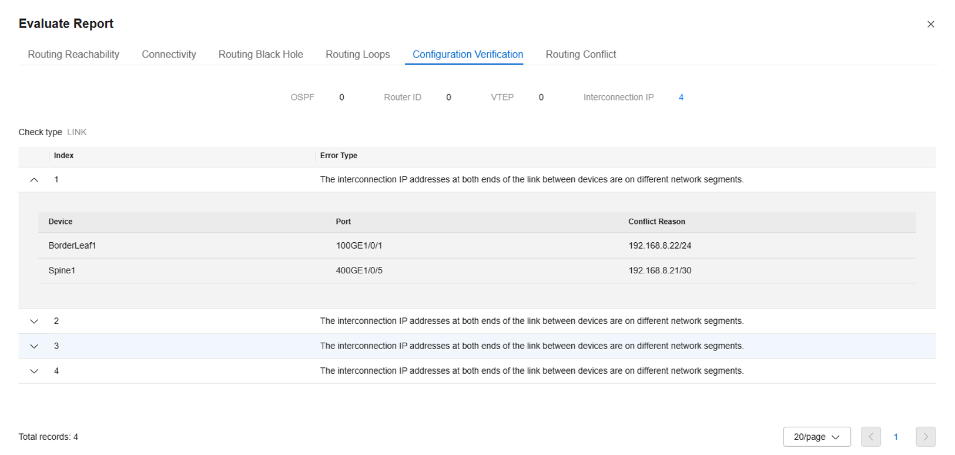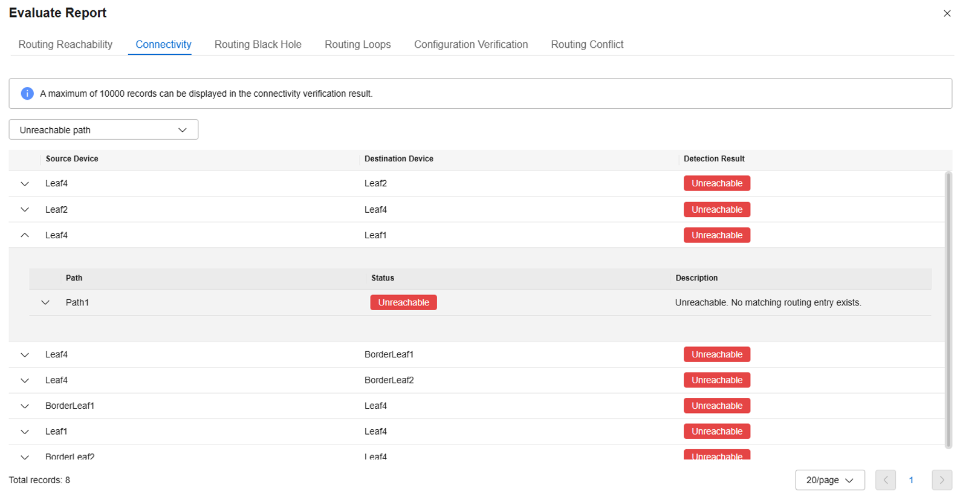1.2- Network Simulation and Decision-Making
At this point, the NCE-Fabric has already generated the POD design and configuration scheme and could deliver the configurations directly to the network devices. However, performing a verification step before deployment is highly beneficial, as it helps identify and resolve potential issues before bringing the POD online.
This verification step simulates the network based on the generated configuration scripts. The NCE-Fabric simulates the entire network, including all devices, and produces an evaluation report. This report analyzes the network from several perspectives, including routing reliability, overall connectivity, routing black holes, routing loops, configuration verification, and routing conflicts. In our test, the simulation report did not identify any issues such as routing black holes, loops, or conflicts. All routes were reported as reachable, and connectivity between devices was confirmed to be normal.
To verify whether the simulation is reliable in detecting configuration issues, we intentionally modified the configuration scripts to introduce multiple problems. We then reran the simulation to evaluate if the NCE-Fabric could identify the introduced issues.
Blackhole
In this step, we added a static route to the configuration script of one node. The static route `<IP route-static 1.1.1.0 255.255.255.0 NULL 0>` is classified as a black hole route because it directs traffic to the NULL 0 interface. After rerunning the simulation, the evaluation report highlighted these issues in the routing black holes section, as shown in the figure below.

Figure 4: Simulation Report - Routing Black Hole
Subnet Mismatch
We modified multiple IP addresses in a configuration script for several links to simulate a scenario where the physical interfaces at both ends were assigned to different subnets. We tested two variations: first, by changing the subnet mask while keeping the IP addresses the same; and second, by changing the IP addresses while keeping the subnet mask unchanged. We then reran the simulation. The NCE-Fabric detected the issue in both scenarios and described the problem in the simulation report under the Configuration Verification tab. Figure 5 highlights the issue as it appears in the report.

Figure 5: Simulation Report – Inconsistent Interface IP Addressing
Routing Loop
Routing loops are complex network problems that require wide analysis and elimination and can cause a network breakdown. In this test, we intentionally modified the generated configuration scheme to create a routing loop in the network. This was done by adding two static routes to two directly connected devices, a spine and a border leaf. Each static route pointed to the other device as the next hop for the same destination IP address. After running the simulation, the NCE-Fabric detected and reported the issue under the Routing Loops section. The report included details about the specific routes that caused the loop.

Figure 6: Simulation Report – Routing Loop
Interface Down
We simulated an interface failure scenario to further evaluate the NCE-Fabric’s ability to detect issues before deploying configurations to the devices. This was done by adding an interface-shutdown command to the Leaf 4 configuration script. After running the simulation, the NCE-Fabric identified the issue and reported all affected paths under the connectivity tab as unreachable, as shown in Figure 7 below.

Figure 7: Simulation Report - Interface Down
IP Conflict
To produce a routing conflict and evaluate the NCE-Fabric’s ability to detect it, we modified the loopback address of one device to match that of another. The NCE-Fabric successfully detected this conflict and reported it in the simulation report under the Routing Conflict section. The report included details such as the conflicting IP address and the devices where the conflict was detected. The following figure shows the conflicting IP in the simulation report.

Figure 8: Simulation Report - IP Conflict
This test confirms that the NCE-Fabric meets the Level 4 network simulation and decision-making capability requirements, as defined in ETSI GR ENI 049.
| < Previous | Next > |
